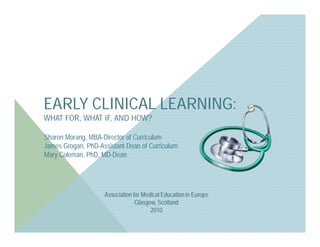
Early Clinical Learning
- 1. EARLY CLINICAL LEARNING: WHAT FOR, WHAT IF, AND HOW? Sharon Morang, MBA-Director of Curriculum James Grogan, PhD-Assistant Dean of Curriculum Mary Coleman, PhD, MD-Dean Association for Medical Education in Europe Glasgow, Scotland 2010
- 2. The medical university is a propriety school held by a publicly traded company with commitment toward developing healthcare education leadership. Enrollment is nearly 400 students per entering class, beginning three times per year. 1. Large percentage (65%) enter primary care 2. Student body and faculty are diverse 3. Faculty work assigned is primarily teaching 4. The education program occurs in geographically distinct regions: a. Basic sciences in the Caribbean region b. Clinical clerkship training in the United States What is unique?
- 3. Background Several factors contribute to the trend toward earlier clinical learning in undergraduate medical education programs. We outline factors driving significant change at a large Caribbean medical school preparing students for practice in the United States that are consistent with adult learning theory. Summary of Work Planning for curriculum change has involved modification of the existing clinical education program and increased emphasis on learning competencies related to professionalism, systems, improvement, and patient centered care. Factors which were challenging in creating a strategy toward inclusion of greater clinical learning were increased class sizes and faculty ambivalence towards change. Summary of Results We summarize measures and parameters of these factors which have led to formulation of plans for curricular change. Conclusions The resulting program implementation suggests that students’ earlier clinical learning experiences can be improved by enhancing existing programs, such as community medicine projects and problem- based learning, while also implementing new early learning experiences through the use of standardized patients and simulations. Abstract
- 4. Recommendations from Accrediting Institute of Medicine Greater emphasis on competencies, clinical Organizations recommendations education, and EBM Increase early clinical exposure Address patient Proposed safety, systems, changes to Drivers for cultural Licensure Exam Change competence, science 40% first time foundations pass rate Inadequate writing and examination Feedback from skills Student performance on Clinical Faculty internal assessments regarding student (Comprehensive NBME) preparation Drivers of Curriculum Change These drivers were integral to underscoring the need for change while providing an opportunity to apply adult learning theory.
- 5. Outcomes of Curriculum Revisions Greater requirements for written case histories Creation of a Department of Integrated Medicine Doubled semester 3 clinical exposure Expansion of hi-fi simulation and task-trainers into first 4 semesters Hired more US trained clinicians and visiting faculty Initiated Standardized Patient Program Use of WebSP and Doc.com for feedback on clinical skills Addition of service learning to allow more contact with real patients Adoption of an organ systems-based curriculum
- 6. What went well: Key changes implemented: Engagement of faculty in module development teams across departments. . Increased number and feedback on written case histories (H & Ps) for students. .. Adoption of team approach to integrated interactive clinical cases that emphasize relevance of basic science concepts and applications to clinical medicine. Clarification of processes and ideas through workshops: . Simulation .. . Utilization of technology software to Clinical Cases improve education Support of students by participation in Incremental change process with respect development teams for requested implementation delays Reflections on Transition Process
- 7. Barriers to Change A. Lack of engagement of all department chairs B. Increased enrollment simultaneous with curriculum change with closing of a second campus C. Unclear communications to students regarding registration caused delays in implementation D. Not all faculty provided new learning objective to support the implementation Reflections continued…
- 8. 1. Clinical learning experiences were increased demonstrating the application of adult learning theory. 2. In an environment of sustained growth in student numbers, making curricular changes is challenging and evokes strain on mid-level administration. 3. Despite efforts to communicate reasons for change and processes to achieve outcomes, morale was a continual challenge. 4. Curricular change needs resources such as software technology to support database maintenance and extra administrative assistance. 5. Changes not directly related to original goals can be implemented during periods of curriculum change. 6. Incremental changes contribute to easing anxiety amongst faculty toward curriculum change. Findings
- 9. References Grant, J. (2006). Principles of curriculum design. Understanding Medical Education monograph series. Oxford: Education, Blackwells Press. AAMC. (2008). Recommendations for Clinical Skills Curricula for Undergraduate Medical Education. Association of American Medical Colleges. Merriam, S., Caffarella, R. & Baumgartner, L. (2007). Learning in Adulthood: A comprehensive guide, 2nd edition. San Francisco: Jossey-Bass.